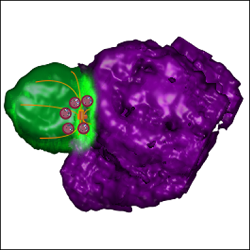
Cytotoxic T lymphocytes (CTLs) of the immune system combat virally infected and cancerous cells. Killing is finely controlled according to the strength of signal generated upon T cell receptor (TCR) recognition of targets. Exactly how these changes in signal strength were able to control the multiple intracellular pathways that lead to polarization of the secretory machinery to control the strength of killing was not known.
Publishing in the Journal of Cell Biology, Dr Gordon Frazer and colleagues from the lab of Prof. Gillian Griffiths show that the pathways orchestrating polarized secretion and killing are conserved irrespective of signal strength. However, increasing the strength of signal increases the rate of initiation along these pathways. Using 4D imaging of CTLs encountering targets with different signal strengths it was possible to quantitate each of the steps required for secretion including dwell time, Ca2+ fluxes, centrosome docking and granule polarization. These results showed that TCR signal strength modulates the rate but not the organization of CTL responses. These results build on previous studies on transcriptional and signalling activation from the Griffiths and Marioni labs that support an emerging model of signal strength controlling the rate of progression along conserved pathways.

